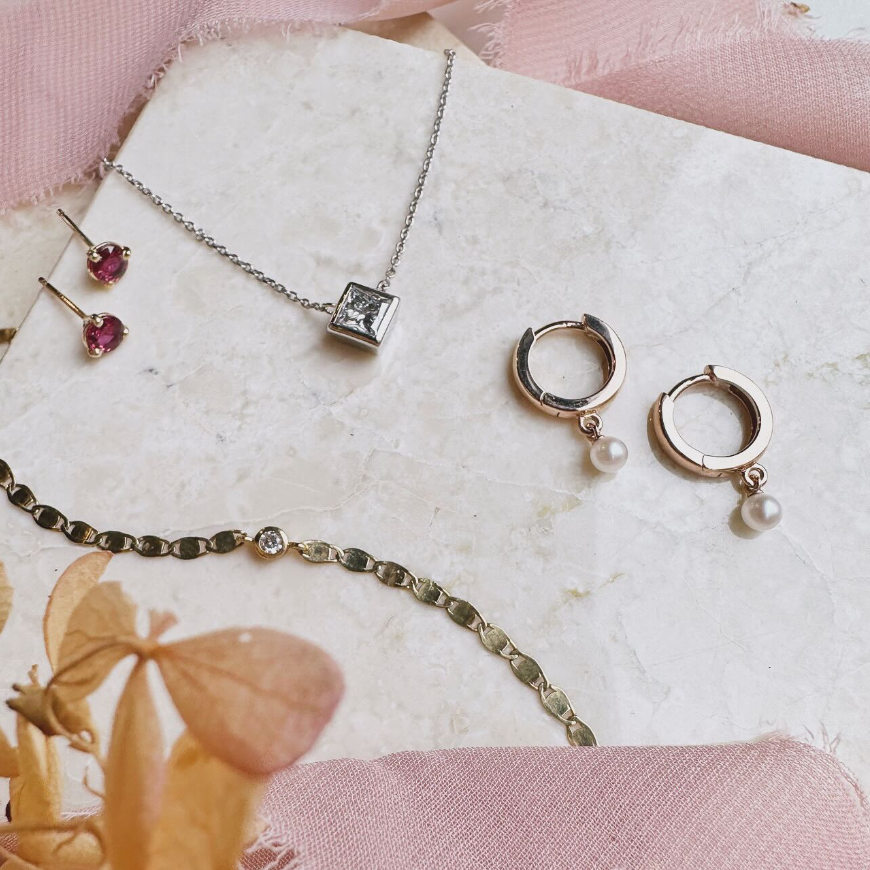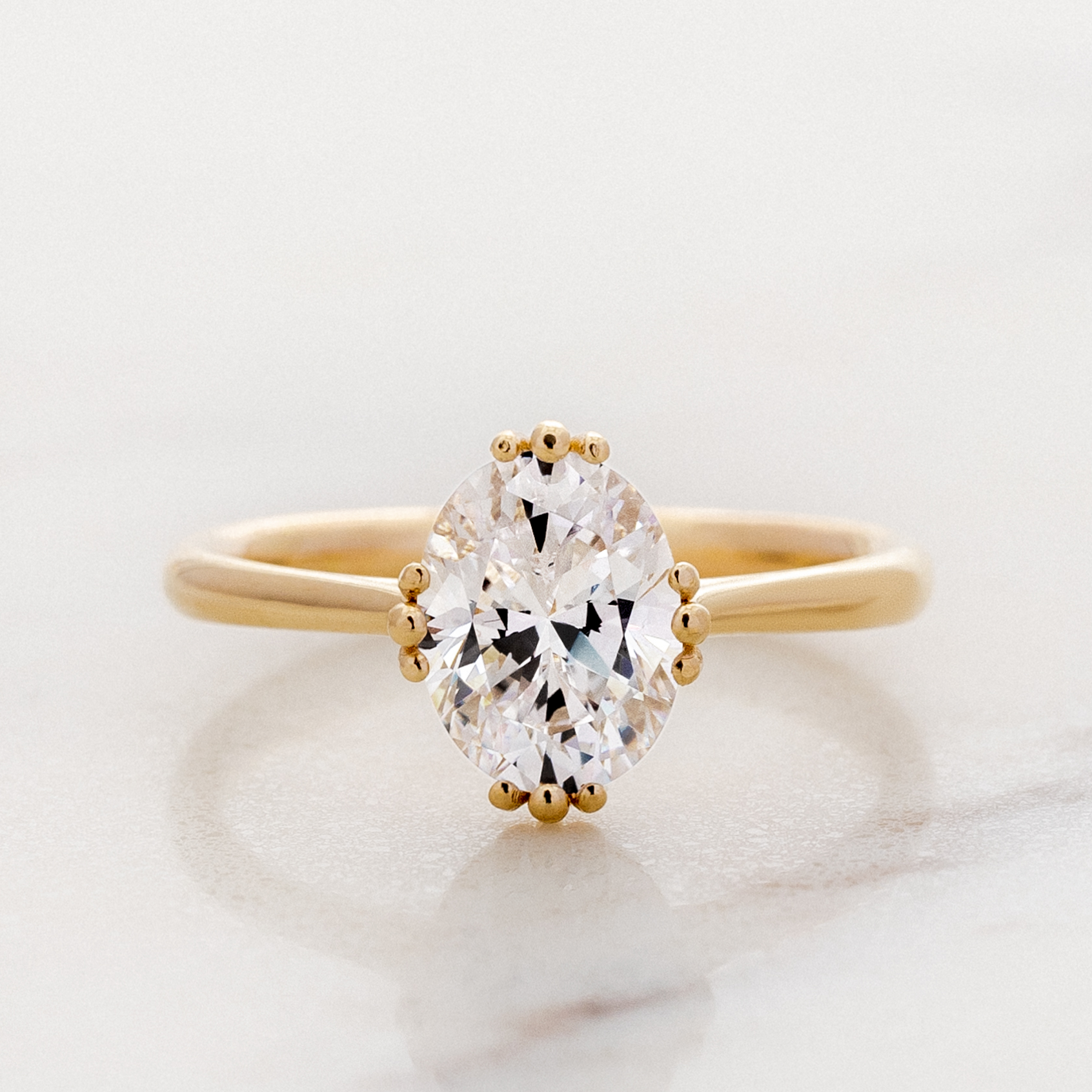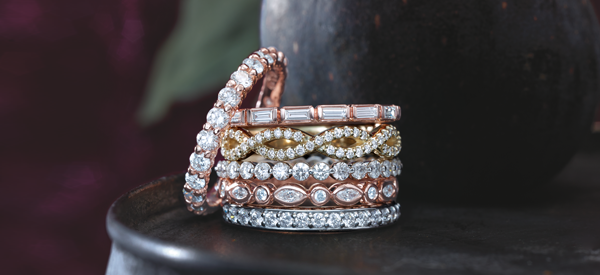Choosing a Center Stone
Woohoo! It's time to shop for an engagement ring! Selecting a ring is easier when broken into two parts: the center stone, and the mount. Here, we'll look at the basic options and things to consider for your center stone:
Types of Center Stones
An engagement ring is meant to be worn every day, and the center stone needs to be hardy enough to handle day to day life. For this reason, I recommend diamond, moissanite, and sapphire as the three best center stone choices. Sapphire is the best option for color, and diamond and moissanite are the best choices for a white, sparkly center stone.

Diamonds
Diamonds are the hardest material on earth - they are 58 times harder than any other material from nature! All diamonds are graded according to the Four C's - Color, Clarity, Cut, and Carat.

Lab Grown vs. Natural Diamonds
Lab grown diamonds are chemically and optically identical to their naturally mined counterparts. For all intents and purposes, a lab grown diamond looks identical to a natural one. You need special equipment to tell the difference between the two, and the biggest difference that buyers notice is the price! Lab grown diamonds are graded exactly the same way, and can still have inclusions, low color grades, and poor cuts. Working with a jeweler who understands the 4 C's is crucial to getting the best value in your stone, finding the best balance between visual and financial impact. Lab grown diamonds are also called "synthetic" diamonds (made by humans as opposed to nature), but calling them a "simulant" is not accurate.
Moissanite
Moissanite is an amazing gemstone, found only in very tiny quantities in nature. While diamond is carbon, moissanite is a silicon carbide - this gives the stone a lower hardness rating, but a higher refractive index. Since light travels through the moissanite differently, it is technically (and measurably) sparklier than a diamond, and you'll see more 'prism effect' and rainbow light. It's quite hard to tell the difference between moissanite and diamond without a trained eye, and so it makes a fantastic diamond alternative. Because of the rarity of moissanite in nature, the moissanite used in jewelry is grown in a lab - which makes it a very budget friendly option as well.
You can see a video of a diamond and a moissanite next to each other here.
The curveball: Salt & Pepper Diamonds
Salt & Pepper Diamonds, sometimes called "Galaxy Diamonds," are diamonds that have a lot of 'inclusions' - little cracks/fissures/crystals that happen naturally while the diamond forms in the earth. They are earth mined diamonds, come in many shapes and colors, and have a very different look than the traditional white, sparkly diamond. Below are some photos of salt & pepper diamonds!



Center Stone Cuts & Shapes
Any one of the stones above will come in many shapes and cuts. "Shape" refers to the silhouette of the stone when viewed from the top. "Cut" refers to the faceting style of the stone.
Shapes
A round cut diamond is always the most popular and most often seen because of the classic, timeless shape that is flattering on all hands. Oval and pear shapes are also very popular at the moment. Below is an image showing some of the most popular shapes available.

Stone Cuts
Most engagement rings use stones cut with traditional faceting (sometimes called "brilliant cut"), where the top of the stone is flat and the bottom of the stone (called the pavilion) comes to a point. No matter what shape the stone is from the top view, the side view resembles an ice cream cone. Only diamonds with this cut will come with a laboratory report. Traditional faceting is done to optimize the way the light travels through the stone for maximum sparkle.
There's another style called "rose cut" where the top of the diamond is domed, and the bottom is flat or slightly domed. This style has a more subtle sparkle, sometimes called a lustre. I personally recommend a "double rose cut" where both the top and bottom of the stone is domed - more facets mean more sparkle and less 'windowing' (where you can see through the stone to whatever is behind it). Salt & pepper diamonds are often rose cut because the inclusions mean a brilliant cut isn't necessary (but they are available in traditional faceted cuts as well).
Below are some images to show the difference. Although most show round stones, any shape can be rose cut.





Pricing
All of the options above effect pricing, but graded diamonds (that come with a lab report) will always be the most expensive. Below are visually comparable examples of each stone type noted above in a round cut, including pricing, to give you an idea of the general price range that each falls in.
Salt & Pepper Diamonds have so many variants and prices that we would need to narrow down some more details before I can provide pricing. If you're interested in that style, let me know! In general, prices can range from $700-3000 for a 1ct stone, depending on color, inclusion type, etc.
 Natural Diamond: 1.00 carat round brilliant cut. G color, SI1 clarity, Excellent Cut. 6.39mm. $6700
Natural Diamond: 1.00 carat round brilliant cut. G color, SI1 clarity, Excellent Cut. 6.39mm. $6700 Lab Grown Diamond: 1.00 carat round brilliant cut. G color, SI1 clarity, Excellent Cut. 6.47mm. $2900
Lab Grown Diamond: 1.00 carat round brilliant cut. G color, SI1 clarity, Excellent Cut. 6.47mm. $2900 Moissanite: 6.5mm round brilliant cut (comparable to 1ct diamond). DEF color, high clarity. $390 (nope, that's not a typo!)
Moissanite: 6.5mm round brilliant cut (comparable to 1ct diamond). DEF color, high clarity. $390 (nope, that's not a typo!) Natural Diamond: 6.5mm round rose cut. G/H color, VS/SI clarity. $2600
Natural Diamond: 6.5mm round rose cut. G/H color, VS/SI clarity. $2600 Moissanite: 6.5mm round rose cut. D/E/F color, high clarity. $240
Moissanite: 6.5mm round rose cut. D/E/F color, high clarity. $240





